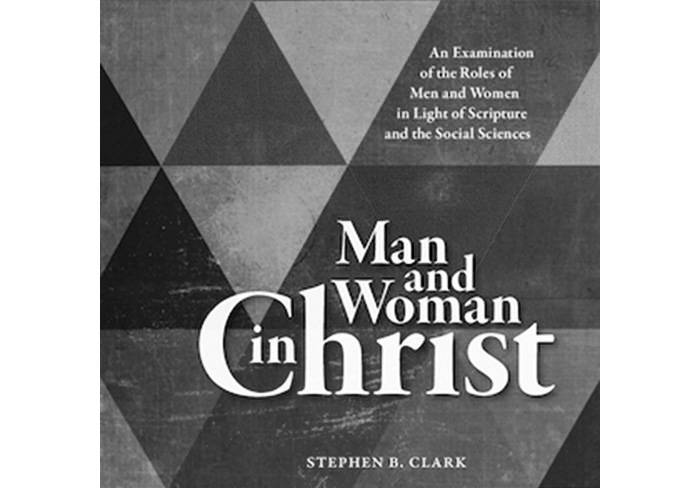In the iconic film The Wizard of Oz, the main character is beginning to realize that she and her dog have been transported to a different land. “Toto,” she says to him, “I’ve a feeling we’re not in Kansas anymore.” A lot of people have had a similar experience to Dorothy. Things have changed enormously since Steve Clark wrote his book Man and Women in Christ: An Examination of the Roles of Men and Women in light of Scriptures and the Social Sciences, and unlike Dorothy and her dog, not changes for the good.
The title of Clark’s book is not catchy – not the kind that would reach out and grab your attention. It doesn’t cause you to say to yourself, “I’ve got to get that book and read it.” Nor is the title pithy and easily memorized or repeated. Besides that, it is a big book, over seven hundred pages long. Those who know Steve Clark would smile at all of this, because the title so aptly captures much of not only the book but something of the heart and person of the author.
The book is dispassionate in its style, thorough, balanced, well researched and clearly written. And while the author is not polemical and shrill, he is quite clear on the matter at hand and its importance not only for Christian life but for human life. He covers a great deal of territory in the book: key Scriptural texts and how interpretation of the texts has developed or devolved over the years; what social sciences have to say about the area of men’s and women’s roles; the importance of understanding technological society and the enormous impact technology has had on how human life works; the emergence of a set of ideologies and their impact on how people understand and think; and lastly a whole set of issues or factors involved in how to think about a Christian approach to the whole area today. That is a lot of territory to cover.
There is a central overarching theme that underlies the work as a whole, and that has to do with the vital importance of God’s plan for the human race. That plan was inscribed into creation, and in particular into the creation of Adam and Eve – and their descendants. It has to do with the relation of man to woman, and of man and woman to their offspring. It further has to do with the way their life was to be put together and structured. The social structure that unfolded is a key part in the overall creational story.
I would like to meander a bit through a set of reflections having to do with Clark’s book and some of the main themes in it.
In particular, I would like to note that the issues of technology and ideology that Clark has identified have increasingly deepened their hold on the modern world, in ways that perhaps even he could not have imagined. I suspect that if a person time traveled from the 1950s, say, to 2022, and read the newspaper or watched the news they would be incredulous regarding what they were reading or hearing. And, of course the Christian churches are caught up in the midst of it all. And they are all struggling to find a way to respond. Clark is exceptionally prescient in both his diagnosis and in the remedy that he proposes.
In the 60’s and early 70’s there was more “discussion” about “roles” of men and women, with particular reference to the inherent evils of patriarchy and the systemic oppression of women. The solution for people through the years was to reject the outmoded and oppressive structures of patriarchy and allow women to do any job, hold any position or role that had been previously restricted to males. It was seen as a matter of justice and equality of rights. The religious and cultural basis for division of roles was dismissed as simply the product of a bygone historical period, and we were now able to see more clearly the truth of the matter. That discussion had its day, and now it has moved on to other matters.
When younger people in the West hear about “roles” of men and women they tend to find it “quaint” and “peculiar.” And of course, the underlying momentum has continued into new realms—same sex relationships, gender identity (56 possibilities for that one), gender-reassignment surgery and so on. As Dorothy said to her dog Toto when they landed in Oz: ”Toto, I’ve a feeling we’re not in Kansas anymore.” No, indeed we’re not.
Clark’s book is about the roles of men and women, but it is about much more than that. Let’s look for a moment at the Scriptural account. It begins of course in the book of Genesis—the account of the “beginnings.” The story about Adam and Eve in the garden conversing with God in the cool of the day, and the tree in the center of the garden, and the serpent is located precisely within the context of the “creation” account. It does have to do with the reality that creation presupposes a Creator.
There are some big, some very big questions afoot in all of this: Is it all really a creation or did it just somehow emerge on its own? If it all didn’t just emerge on its own, then it brings into discussion the issue of a Creator – which raises the teleological question – why was this world created? Why was Adam created as a male? Why was Eve created as a female? The account in the story describes the creation of Adam and Eve – and a part of the account is their sameness, their difference and the telos of their relationship – being drawn to one another so as to become the source of new life. The serpent enters the picture and things begin to go sideways. But that doesn’t vitiate the teleology of it all. As the story unfolds, we see the sorry plight of Adam and Eve as they discover that they really aren’t the source of the true and the good, and see the result of believing that they were.
The account goes on to describe the origin of fratricide and how that became the first instance of a bad relationship between brother and brother. The unravelling continues and results in the flood. And yet God intervenes, using a “righteous and just man” to begin again the human race. It then moves on the recreation account—God directly intervening to reconstruct the human race according to his plan and design. As we know, in this reconstruction Abraham was a key figure.
Leon Kass, in his study of Genesis (The Beginning of Wisdom), spends a good deal of time on the Abrahamic narratives. He notes that in these narratives God was teaching Abraham about two things: 1) the meaning of being a husband, and 2) the meaning of being a father – a patriarch. And in this God was teaching Sarah: 1) the meaning of being a wife, and 2) the meaning of being a mother. The account of Cain and Abel was about the meaning of being brothers – by the graphic example of what happens when this goes awry. The account of Noah is another part of this familial narrative – the call and role of a father within a family. Clearly the creational account spends a great deal of effort and time on the whole area of men and women, husbands and wives, fathers and mothers, sons and daughters, brothers and sisters.
Throughout these narratives there was revelation and instruction about all of these fundamental human realities. These accounts are a key part of the revelational content of Genesis. They have to do with God’s creational intent for the human race – which in large part has to do with forming the “right” kind of environment for human life to be lived, formed and nurtured and passed on (and by graphically illustrating the tragic results when this didn’t happen). And the context for this was a man and a woman living together in a certain way – a pattern in which men and women became a husband and a wife, a father and a mother. It was within this context that human life was to be conceived, formed and passed on.
This family life was the basis of the broader family – the clan, the tribe and later on the Nation as a whole. The further developments of “the people,” the revelation of the law and the birth of a nation all came out of this familial reality. This was all founded on, indeed originated from, God’s design for the human person, and how the human person was to live as one created in the image of a God who is personal and who lives in his very inner nature a life of union and fellowship.
It is this social structure that was an inherent dimension of how human beings lived and understood their lives. That is, until two other realities emerged that have had a great impact on modern life. In Man and Women in Christ, Clark identifies these two realities—technology and secondly, ideologies. These two realities have greatly shaped how modern life works, and how people understand themselves and the world in which they live. At its core, technology identifies “technique” as paramount, driving reality in modern life. Technology influences and shapes not only what a person does in life as a job or a career, but how a person approaches and lives his or her life. It has led, on the one hand, to a kind of broad-based functionalism – the key determinant in a person’s life is what they “do,” their function. This function determines where they live and how they spend most of their time and energy. Realities such as family, neighborhood, Church, state, etc. are subservient to what the person needs to do to fulfill their function.
Coupled with technology is the reality of ideologies – ways of looking at, interpreting and understanding the self and the world that the self inhabits. Marxism is perhaps the most well-known ideology. There is a whole raft of others operative today. There is a kind of romanticism that is based on a person identifying not only with what they do, but with believing their deepest personal identity, located and centered in their feelings – that is, our feelings are the real “me,” the deepest and most real dimension of who I am as an individual. This is closely related to what is called “expressive individualism,” that the heart or core of the human person is the individual psychological experience of who they are, as mediated through their own emotional truths. There is, as well, the view that the human persons’s sexuality is at the core of who they are. There is involved in this a basic repudiation of history as a source of any kind of authority and wisdom.
With a more Marxist bent, this becomes the conviction that external, objective truths are simply constructs designed by the powerful to intimidate and to harm (and to control and use) the weak. As Carl Trueman notes, “There is no great reality to which we are accountable” (The Rise and Triumph of the Modern Self). The abandonment of all sacred order leaves culture without any foundation. Trueman further notes that both those who hold to a theocentric world view, and those who hold to a secular order based in Western history and culture lack a basis for a meaningful discussion with those who believe in neither the theocentric or the Western cultural perspective – because they do not acknowledge any transcendent authority by which morals and behavior can be justified.
Alasdair MacIntyre in After Virtue notes that in the Aristotelian-Thomist approach a teleological view of human nature and moral action, a particular act can only be assessed in terms of its end – its telos. As McIntyre notes, “A basic repudiation of history as a source of authority and wisdom has removed teleology from the story of mankind” (After Virtue). Another author notes that “the individual is given enormous latitude in fabricating his own particular private life – a kind of do-it-yourself universe” (Peter Berger, The Homeless Mind). In a more colorful diagnosis George Gilder comments: “The liberationists have no idea where their program would take us. The movement is counseling us to walk off a cliff” (Sexual Suicide).
How technology and ideologies have impacted modern life is not restricted to roles of men and women or how leadership functions within the Christian churches. Their impact can be seen across a broad spectrum of life. Some arenas in which this impact can be seen are as follows.
This excerpt from Jim Kolar’s essay is taken from Festschrift — Essays in Honor of Stephen B. Clark, published by the Servants of the Word, © 2023.
You can access the full essay online or download a PDF copy at the Servants of the Word website.
Top image credit: Book cover pic courtesy of the publisher for Man and Woman in Christ.



